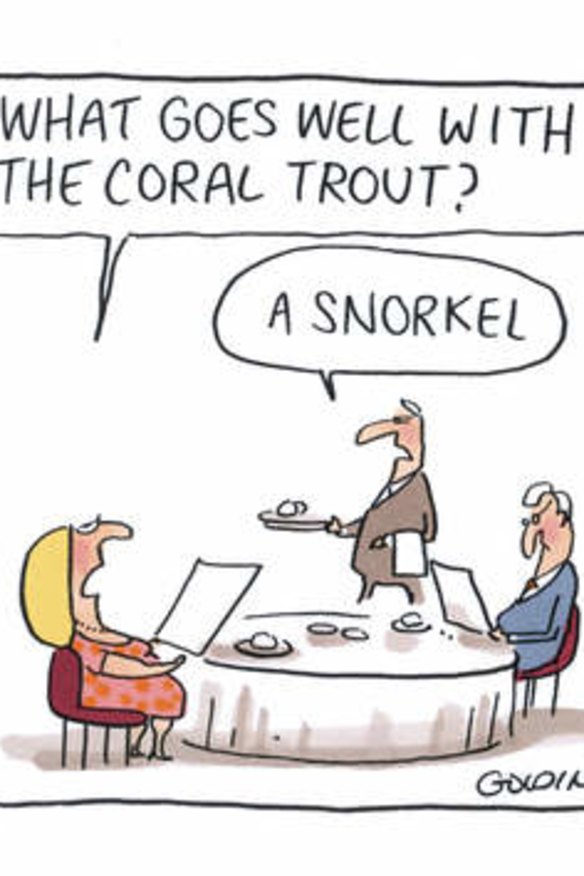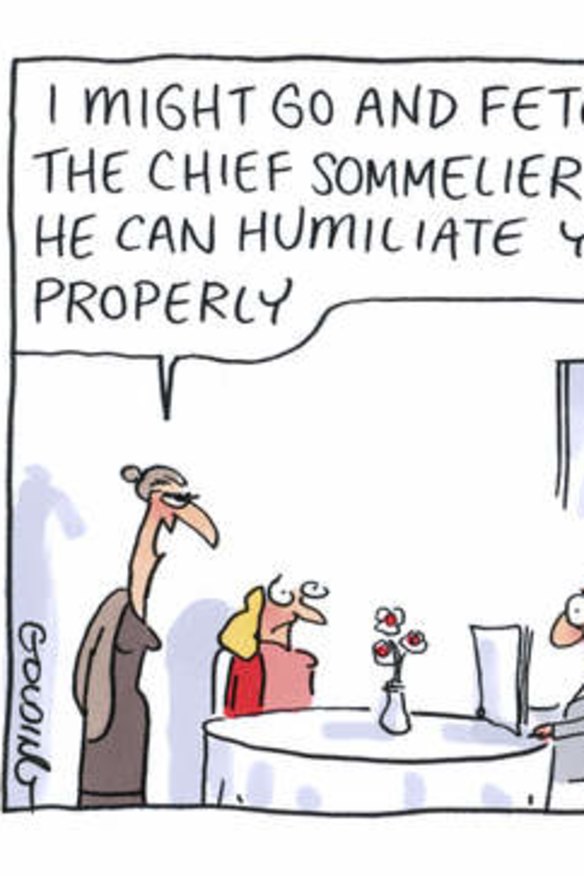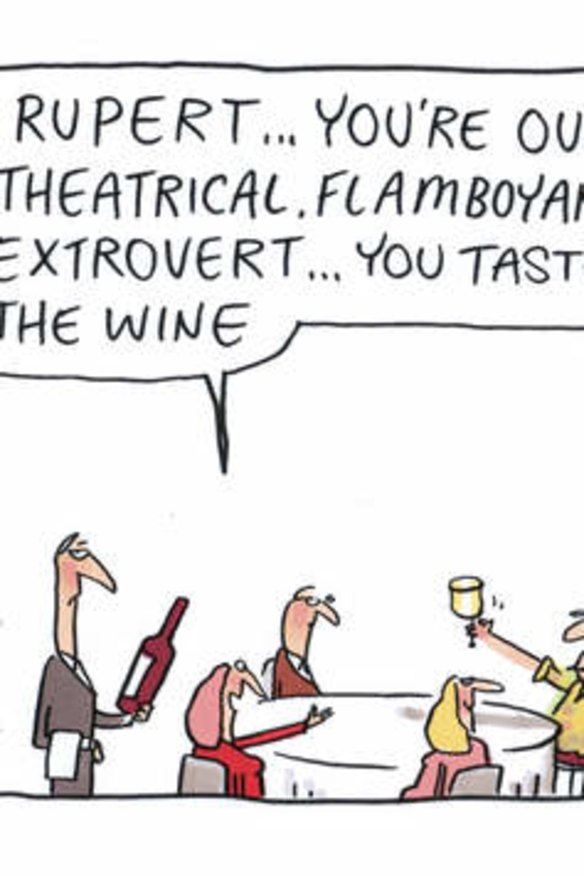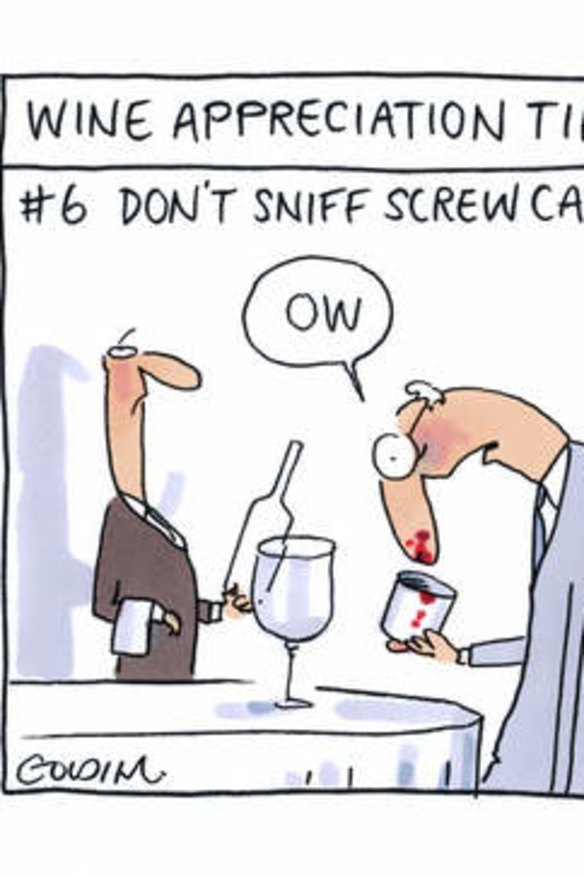Who's afraid of a viognier wolf?
The best sommeliers don't bite, but dealing with them takes practice. Larissa Dubecki has some tips

As the story goes, Hollywood actor Cameron Diaz was visiting "a certain prominent St Kilda restaurant'' in 2006, where the sommelier was trying to indoctrinate her in the attributes of a Chateauneuf-du-Pape. It's one of France's name-checking wine hotspots with one of the more interesting back stories, but Diaz was having none of it: ''Just give me the juice, baby'', she was reported to have brazenly told the (no doubt enthralled) somm.
You've got to respect her chutzpah. Just like that - pop! - the vapour surrounding the often awkward business of choosing and ordering wine, banished.
But someone unaccompanied by a cloud of Hollywood stardust might be a little more backward in coming forward about their wine ignorance. Like religion, anyone not brought up in the vinous fold might find its rituals arcane going on terrifying, turning what should be a simple process of ordering wine into a nail-biting public performance.

If you want them to just bring you the juice, baby, don't bother reading on. But if you've had enough of bluffing and want to be more confident in the wine department, here's some ideas on how.
How to taste it better
Swirl, sniff, slurp: is it really necessary to put on the theatrics? You certainly don't have to treat it in the noisy mouthwash fashion of some professional tasters, but the smell is an integral part of the experience. The swirl, performed holding the glass by the stem (never by the bowl - body warmth will heat the wine) aerates the wine and releases the vapours. If you're feeling really confident you might want to try slurping air through puckered lips once you've taken a sip, a tactic designed to release aroma and flavour. Be prepared for the derision of your dining companions.

Getting to know your grapes
Chardonnay lovers kept the faith when it became the butt of jokes thanks to the over-oaked abominations fashionable in the 1990s; now it's sauvignon blanc's time in the sin bin, as Julia Gillard found out when the cellar at the Lodge was widely derided for its low-cost New Zealand savvy b's. Why the fall from grace? A grape becomes popular, growers leap enthusiastically on board, a glut ensues, quality goes south. It's time to step away from the Oyster Bay sauv blanc.
There is a greater diversity of wines than ever before. So what to choose? Pinot gris and grigio are taking off in popularity; vermentino and gruner veltliner are cool in more ways than one, and tempranillo is a big name in reds. Start with the major grapes, learn what you like and branch out from there. You enjoy a riesling, so try a gruner veltliner; pinot noir floats your boat, so try a nice middle-weight grenache.

How to buy it better
Some fundamentals before venturing to your local bottle shop: A varietal is made entirely from one grape variety. In Australia and the rest of wine's new world, the grape will be displayed prominently on the label. Wine labels from the old world (Europe), however, traditionally display the region in which they are made rather than the grape - hence, Burgundy is synonymous with pinot noir. A blend is made from more than one varietal, such as a semillon-sauvignon blanc or shiraz-viognier. The vintage is the year the grapes were harvested - important information on a wine list as wines can vary greatly year to year depending on weather and other growing conditions. Champagne or sparkling is typically non-vintage.
And before we move on, it might also be useful to know that what we know as shiraz is elsewhere commonly called syrah.
How to order it better
The sommelier will be that person with the grape badge stuck to their lapel, or at the newer, looser style of restaurant, the bloke wearing an apron that says ''the Wine Guy'' (it certainly takes the guesswork out of the process). A good sommelier has ''humanity, humility and
humour'', the wine director for Guillaume Brahimi's group of restaurants, Chris Morrison, says. ''The great sommeliers don't release a torrent of information to bamboozle the customer, just a cup.'' The sommelier should ask about the food you have ordered and about your budget. Put them to the test: ask for recommendations from a few different regions. Remember what you've enjoyed before and ask for something similar.
The tasting ritual - whoever ordered the wine will be given a small pour to approve - isn't about whether you like the wine or not. You are simply checking the wine for signs of taint. If there's nothing wrong with it, you're obliged to pay for it. Don't worry about performance pressure: it doesn't matter if you don't detect it until part-way into the bottle, although a simple sniff can often reveal problems such as oxidisation (think of it as stale wine; it will smell something like sherry), sulfur (really offensively stinky) or cork taint (it smells musty and dank: ''wet newspaper'' is a common descriptor). Corked wine is rare now 85 per cent of wine sold in Australia is under screwcap. Reminds us of the sommeliers' joke: ''It's not corked, but it's definitely screwed.''
How to match wine with food
White wine and seafood; red meat and a hearty shiraz. Sure, sure, but what about the old rule that red wine went with cheese, until that was debunked when it was realised that the high fat content meant the higher acidity of white wines would make a better match.
Bugger the dogma. It's far more acceptable these days to try previously heretical matches. Don't worry so much about the colour of the wine: the key principle is to match the body - the sense of weight or viscosity the wine leaves in your mouth - with the ''weight'' of the dish. Pairings become classic because they work so well: duck and pinot, or shellfish and riesling. But if you want to bust out a move like seared tuna with sangiovese, go for it. Champagne (or sparkling) can be a great go-to move for a tricky one such as sushi. It's okay to break a few rules. If your sommelier dares sneer, get a new sommelier.
How to read a wine list better
Bigger isn't necessarily better. A wine list can be a haiku, a short story, novella or novel, and one doesn't necessarily have the jump on the other (yes, dear, it's what's inside that counts). The wine list is the profit engine of a restaurant, commonly divided into three nominal sections; value for money, middle tier, and out there. A wine list is built like a menu, with lightest and freshest through to heaviest and richest, so at the simplest level look at where you are on the menu and go to the corresponding part of the wine list.
Modernity is on your side: more lists are ditching the old varietal headings and opting for divisions based on palate weight, such as ''light, floral and fragrant'' (think riesling or sav blanc), ''medium-bodied and textural'' (like pinot grigio). Wine-storage technology means wines can be kept longer after being opened; wines by the glass give a snapshot of a restaurant's wine philosophy and are dead handy for the novice to take an overview. Undecided? Ask to have a small taste of any wine offered by the glass.
The ascendancy of more obscure European varietals - the lesser-known Italians are pretty big right now - can help cloak ambitious mark-ups. The profit-margin police might want to jump on websites such as winerobot.com, which compares retail prices. A normal rule of thumb is a 150 per cent to 200 per cent per cent mark-up in a restaurant - less at the higher end of the list.
And finally …
Wine is a weird fusion of art and science, with a good measure of high-falutin' rhetoric thrown. When quality is measured by taste, experience counts for everything. Make friends with a specialised retailer offering informed service. And remember: drinking better isn't about impressing anyone or becoming the next uber-critic like Robert Parker and insuring your nose for a million dollars. It's simply about enjoyment.
Larissa Dubecki is a Fairfax food writer and reviewer in Melbourne.
